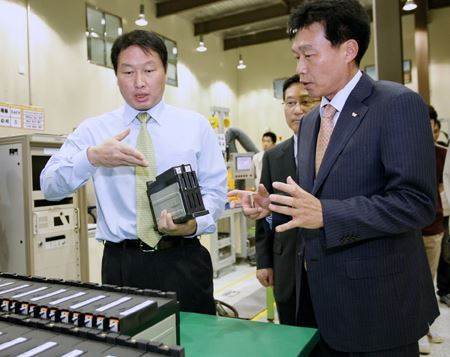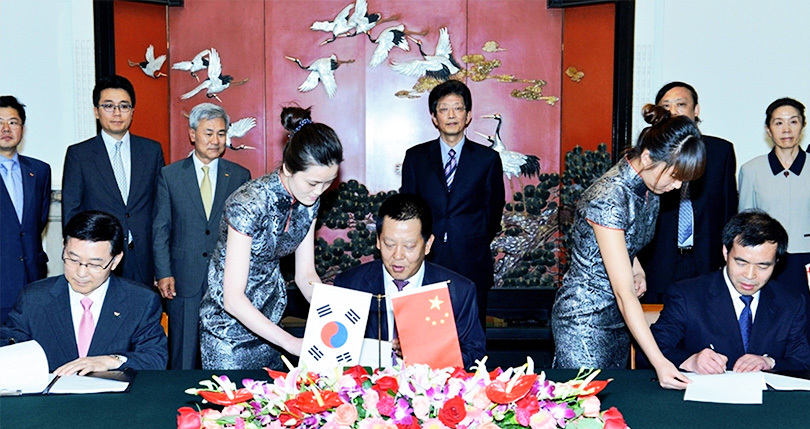 |
SK Group Chairman Chey Tae-won (left) visits the SK Innovation Institute of Technology in June 2011 to show his strong commitment to the EV battery business. During the visit, Chey said, "The battery business will keep running until the day all cars use SK batteries. I will also run with it." (SK Innovation) |
SK Innovation, the battery and new energy affiliate of SK Group, entered the battery market in 1996 and started off with large-storage lithium-ion batteries just two years later.
Thanks to two decadeslong coating technologies accumulated at chemicals maker SKC, the company was able to complete world-class coating and assembly technologies for lithium-ion batteries at the time.
SK’s focus was on lithium polymer batteries, making them lighter and in new form factors like the prismatic-type. The initial research was conducted at both the Cheonan and New Jersey R&D Center.
In 2005, the company embarked on an expansion of battery manufacturing infrastructure using some 60 billion won ($53.1 million) worth of funds invested in SK Mobile Energy, a lithium polymer business spun off from SKC.
The following year, SK Innovation test-ran its first large-size lithium-ion battery for hybrid vehicles in the United States.
According to news reports at the time, the company had begun to develop batteries for hybrid cars in 2004 and completed it in March 2006 and conducted test-runs with Toyota for three months.”
The SK batteries had shown over 10 percent improvement in energy efficiency, the reports said.
In 2009, SK signed a battery supply deal for mid- and large-size hybrid cars with Mitsubishi Fuso, an affiliate of Germany’s Daimler Group.
Then the company partnered with Hyundai Motor Company as an EV battery supplier in March 2010 as part of a state-run project led by then-Ministry of Knowledge and Economy.
SK’s first 16.4 kilowatt-hour lithium polymer battery was adopted for Hyundai’s first high-speed EV Blue-on.
The Korean battery maker further succeeded in clinching meaningful deals with global carmakers like Mercedes-AMG in 2011 and China’s Beijing Automotive Group in 2013.
“News reports at the time said the deals were proof of SK’s technological prowess in batteries,” an SK official said.
 |
SK Innovation signs a contract to establish an EV battery joint venture with Beijing Automotive Group and Beijing Electronics on July 5, 2013. (SK Innovation) |
After the China deal, SK established a joint-funded battery factory in Changzhou in 2019, which started mass-production the following year. Since then, the plant has served as a key battery production hub for Beijing Automotive’s EV brand Arcfox.
In Korea, the first EV featuring SK batteries was Kia Motors’ Soul in April 2014.
SK and Kia had partnered since 2012 to co-develop the most capable EV battery with a capacity of 27 kWh.
SK’s battery plant in Seosan, South Chungcheong Province expanded its production capacity from 15,000 units a year to 30,000 units in 2015 in line with the growing market size.
SK went on to supply battery cells for Daimler-Benz’s EV models in 2016.
The rapid growth in demand had the company again ramp up its Seosan plant with a total production capacity of 4.7 gigawatt-hours in 2018.
The Korean company since then has been making aggressive investments to expand its overseas capacities.
Across the globe, SK has secured infrastructure to produce about 30 GWh batteries at plants in China, Hungary and the United States.
By 2025, the company aims to be able to produce up to 125 GWh, which can churn out 50 KWh batteries for 2.5 million vehicles every year.
(
khnews@heraldcorp.com)









